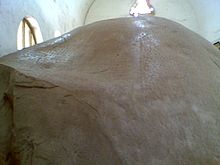Rudradaman I
[citation needed] Sātavāhana dominions were limited to their original base in the Deccan and eastern central India around Amaravati:[2] "Rudradaman (...) who is the lord of the whole of eastern and western Akaravanti (Akara: East Malwa and Avanti: West Malwa), the Anupa country, Anarta, Surashtra, Svabhra (northern Gujarat) Maru (Marwar), Kachchha (Cutch), Sindhu-Sauvira (Sindh and Multan districts), Kukura (Eastern Rajputana), Aparanta ("Western Border" - Northern Konkan), Nishada (an aboriginal tribe, Malwa and parts of Central India) and other territories gained by his own valour, the towns, marts and rural parts of which are never troubled by robbers, snakes, wild beasts, diseases and the like, where all subjects are attached to him, (and) where through his might the objects of [religion], wealth and pleasure [are duly attained]".Rudradāman conquered the Yaudheya tribes in present day Haryana, as described in the Girnar rock inscription of Rudradaman.Rudradaman refers to the Yaudheyas as a militant republic of kshatriyas that confronted him as opposed to submitting:[7] "Rudradaman (...) who by force destroyed the Yaudheyas who were loath to submit, rendered proud as they were by having manifested their' title of' heroes among all Kshatriyas.[2] The inscription relating the marriage between Rudradāman's daughter and Vashishtiputra Satakarni appears in a cave at Kanheri: "Of the queen ... of the illustrious Satakarni Vasishthiputra, descended from the race of Karddamaka kings, (and) daughter of the Mahakshatrapa Ru(dra)....... .........of the confidential minister Sateraka, a water-cistern, the meritorious gift."Rudradaman (...) who obtained good report because he, in spite of having twice in fair fight completely defeated Satakarni, the lord of Dakshinapatha, on account of the nearness of their connection did not destroy him.He in fact repaired the embankments of the lake Sudarśana, which was constructed by the Mauryas for checking floods.
Obv: Bust of Rudradāman, with corrupted Greek legend "OVONIΛOOCVΛCHΛNO".
Rev: Three-arched hill or Chaitya with river, crescent and sun. Brahmi legend around (from 12 o'clock):








Western SatrapBritish MuseumJayadamanDamajadasri IRudrasimha IWestern KshatrapasCaṣṭanaSātavāhanaMaha-kshtrapaNahapanakshatrapasDeccanAmaravatiAvantiAnartaSurashtraGujaratMarwarSindhuSauviraMultanRajputanaAparantaKonkanNishadaCentral IndiaJunagadh rock inscriptionChaityaBrahmiYaudheyaHaryanakshatriyasJunagadh rock inscription of RudradamanKushan EmpireGupta EmpireVashishtiputra SatakarniKanheriSatakarni VasishthiputraGautamiputra SatakarniDakshinapathaPhagunaAshokaEdicts of AshokaSkandaguptaJunagadhSanskritMauryansYavanesvaraYavanajatakaWayback MachineWestern SatrapsAbhirakaBhumakaChastanaJivadamanSatyadamanRudrasena IDamasenaVijayasenaDamajadasri IIIRudrasena IIBhartrdamanVisvasenaRudrasimha IIYasodaman IIRudrasimha III